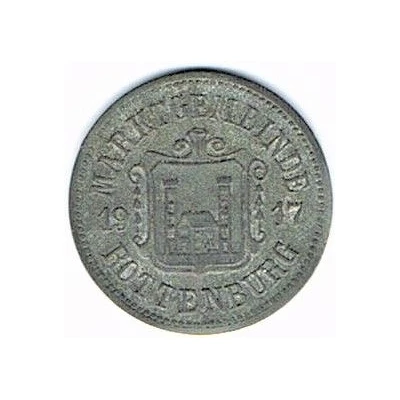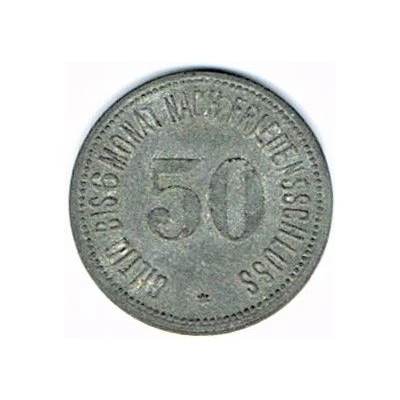


© Kreutzer67 (CC BY-NC-SA)
50 Pfennigs - Rottenburg o. d. Laaber
1917 year| Iron | - | 22.3 mm |
| Issuer | Market Town of Rottenburg an der Laaber (Federal state of Bavaria) |
|---|---|
| Emperor | William II (Wilhelm II) (1888-1918) |
| Type | Standard circulation coin |
| Year | 1917 |
| Value | 50 Pfennigs (50 Pfennige) (0.50) |
| Currency | Mark (1914-1924) |
| Composition | Iron |
| Diameter | 22.3 mm |
| Shape | Round |
| Technique | Milled |
| Orientation | Medal alignment ↑↑ |
| Demonetized | Yes |
| Updated | 2024-10-04 |
| Numista | N#304041 |
|---|---|
| Rarity index | 95% |
Reverse
Pearl rim, legend surrounding denomination.
Script: Latin
Lettering:
GILTIG BIS 6 MONAT NACH FRIEDENSSCHLUSS
50
✶
Edge
Plain
Interesting fact
One interesting fact about the 50 Pfennigs - Rottenburg o. d. Laaber 1917 coin is that it was issued during a time of economic turmoil in Germany, specifically during the hyperinflation period of the 1920s. The coin's iron composition was a result of the wartime economy and the lack of available metals, and it was one of the few coins that were produced during this time that did not have a portrait of a German leader or a national symbol. Instead, it features the image of a woman, representing the town of Rottenburg an der Laaber, and a stylized "50" mark. This coin is now a rare collector's item and a piece of history that serves as a reminder of the economic challenges faced by Germany during that time.